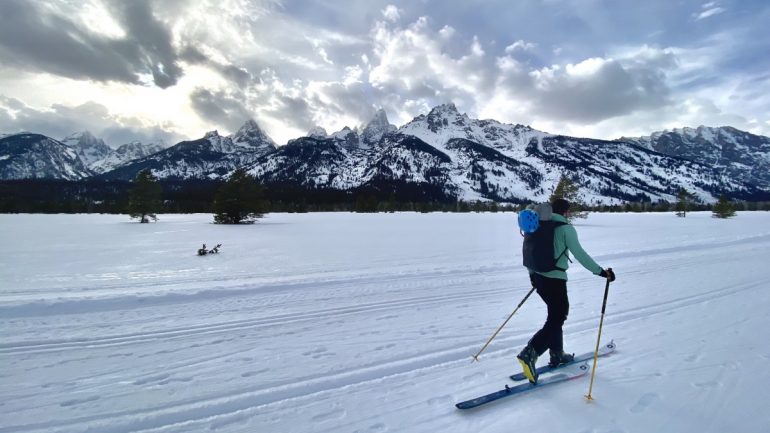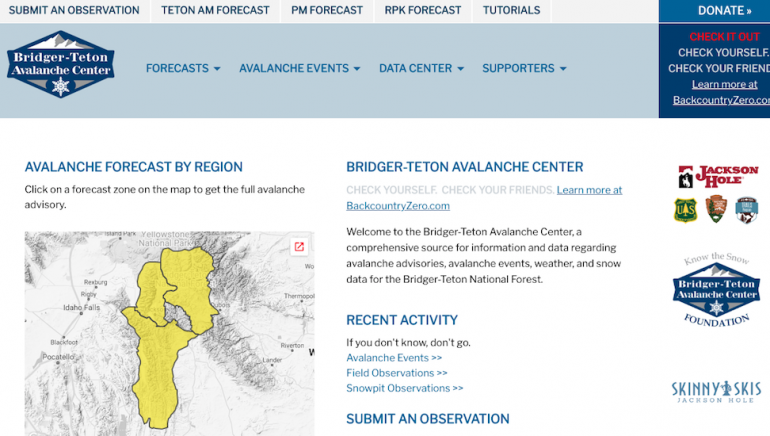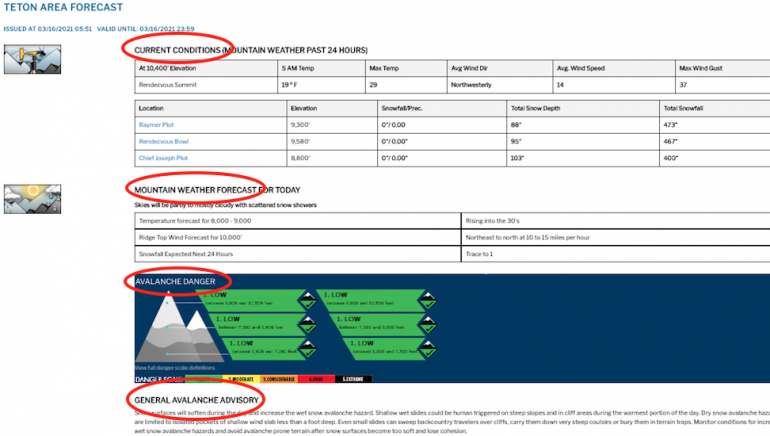
Gavin is approaching camp with a semi-moderate backdrop of the striking Tetons
The Adventure From Home Series follows Slator on a collection of ski trips. Check out Part II of the Tetons here.
This year has brought people to appreciate their local mountains more than ever. Travel restrictions and efforts to reduce the spread of COVID-19 have limited the chance to explore far-off mountain destinations, prompting skiers to re-examine their backyard terrain. The Adventure from Home Series is a collection of trip reports from overnight ski trips I’ve embarked on in the Western US. Each will highlight the possibility of close-to-home adventures in different close-to-home mountain ranges: the Tetons, the Elks, and the San Juans. Each write-up will come in three parts: Plan, Trip Report, and Debrief.
The Plan talks about how we prepared for each tour:
What is the local ski history and culture?
How can I learn about the regional snowpack?
What tools are available to help plan routes and learn about terrain?
The Trip Report talks about the details of our time in the mountains:
What happened while we were out there?
The Debrief reflects on our experience in hopes to improve the process we used for next time:
Did things go according to plan?
What would we do differently next time?
Some context about me: I live in the San Juans and work as a mountain guide. I have close friends in the Tetons and the Elks, so I saw this to be a great opportunity for planning a few ski trips with friends! In the Tetons, I made plans to ski with my close friend and ski partner Gavin Hess. Gavin runs Apocalypse Equipment – a soft goods company that makes custom skiing and climbing packs and other purpose-built softgoods.
Step 1: Learning about local ski history and culture
Chatting with Jeff Dobronyi
“The Tetons are one of the earliest Meccas for mountaineering in the US,” IFMGA mountain guide Jeff Dobronyi explained to me prior to the trip. Jeff is an avid backcountry skier in the winters, climber in the summers, and works with Exum Mountain Guides year round. Since 2016, he has poured time and energy these mountains and this local community of the Tetons.
”The first confirmed ascent of the Grand Teton was in 1898 by a party of six sponsored by the Rocky Mountain Club. First ascents of other high peaks were close to follow,” he continued. “The Tetons were one of the earliest actively climbed ranges in the US. These early ascents act as an example of how American mountaineering, for the most part, began here in the Tetons. Then through the 1960’s, the range became an American alpine training ground for pushing the limit of American alpinism (an example of an epic ascent during that time here).”
After the early mountaineering ascents came an era of steep skiing in the 1970’s. “Bill Briggs made the first descent of the Grand Teton in June 1971 — effectively tapping the ceiling of American steep skiing.” His feat was followed by other impressive descents from characters like Barry Corbet, Mark Newcomb and Steve Romeo. They pioneered “ticky-tacky, gnarly descents on high peaks throughout the Tetons” (here’s a great interview from those times). After the initial wave of steep skiing in the Tetons came Greg Collins, Hans Johnston, Nat Patridge, and others who opened up lines that are still widely regarded as Tetons test pieces or have been rarely repeated (a mind-boggling trip report from that era here).
“Exum as a guiding company has been a keystone resource for this progress of American ski mountaineering.”
The future of backcountry skiing in the Tetons
Considering the rich history of skiing and mountaineering in the Tetons, I was curious to hear Jeff’s opinion on the future of backcountry skiing in the range:
“The increasing popularity of backcountry skiing has positive and negative outcomes,” he said. “Positives being that more skier traffic equals more information about snow and terrain conditions. Everyone shares information in efforts to crowd-source a more accurate understanding of what’s going on in the high peaks, which helps everyone skiing in the Tetons stay safe throughout the winter.”
However, “the negatives of a growing backcountry community means more accidents. This year we had a fatality in a technical ski mountaineering line above a rappel in February and the skier died from trauma. With a general trend of increased skier traffic, accidents like this can unfortunately become more commonplace. The accessibility to dangerous terrain makes things close to the edge here.”
Backcountry ethics in the Tetons
With a bit more knowledge of backcountry skiing in the Tetons, I asked what are important backcountry ethics and values for these mountains?:
“In the Tetons, there is a culture of open communication because it helps everyone stay safe. There are only a few trailheads for touring around here, and that naturally promotes communication amongst the community. Also, respect trail breaking. If people have done a significant portion of the trail breaking, then they get to ski first. That’s a big point of consideration.”
Thank you Jeff for the valuable conversation. Teton ski culture is a collection of each community member’s individual opinions — shared and molded through constant dialogue. Jeff’s is one, and I’m sure there are many others out there to build on this conversation.
Step 2: Understanding the snowpack
A Conversation with Don Carpenter
I next spoke with Don Carpenter, co-owner of American Avalanche Institute (AAI), to get his take on the snowpack in the Tetons. Don has owned AAI (often regarded as the best avalanche education resource in the country) since 2009 and lived in the Tetons since 1993. He gave me insight into the seasonal snowpack history, advice for better backcountry decision-making, and how to prepare for an overnight ski tour.
“This season started off with a below average snowpack in December then caught up to average and had some persistent and deep persistent problems come January/early February. Then in February, it didn’t stop snowing and we managed surface instabilities that occasionally stepped down to the lurking persistent layers built the month prior. After the stormy month of February, March was high and dry and transitioning to a spring snowpack.”
“Now here we are in spring time. There was a theme of high spatial variability this season (meaning particular problems were localized to particular aspects and elevations). One example of that was a persistent and deep persistent avalanche problem on south and southeast aspects at mid elevation. This was a specific problem that we had to manage during the season.”
To get a deeper understanding of the snowpack, I also looked to the Bridger Teton Avalanche Center (BTAC), which catalogs the seasonal snowpack history with a series of weekly summaries. If read from start to finish, the BTAC Snowpack Summaries will read like a short and dry meteorological novelette — neat!

To reach the weekly snowpack summaries on BTAC: DATA CENTER > SNOWPACK INFORMATION > SNOWPACK SUMMARIES
Making better backcountry decisions
After getting the lowdown on this season’s snowpack, I asked Don what advice he could give someone to make better decisions in the backcountry. Hardball vague question — I know. But he shared some valuable knowledge:
“Have a system,” he offered. “Three broad steps for backcountry travel are: Planning, Communication & Debriefing. Build a system that includes these steps and repeat it again and again to improve your decision-making and develop as a backcountry skier. Skiing 100 days in the backcountry versus skiing 100 days in the backcountry with a system is a huge difference. With a system, you intentionally improve your decision-making and grow from every outing.”
The idea of building a system for backcountry skiing is something that I have intentionally put into practice this season. I even have a checklist in my pocket which I’ll run through for every backcountry ski tour. It isn’t perfect and is surely a work in progress, but it creates a framework to structure my decision making for before, during and after a ski tour. (Reach out via email if you’re interested in seeing my current system/checklist for ski touring.)
For more pointed advice with this series, I asked Don what he would tell someone going on an overnight ski tour in the Tetons:
“Do your homework.” he stated. “Always prepare as if you’re going into a new zone and plan objectives according. Even if this is a close-to-home range for you, go into the trip with an assessment mindset. For the Tetons, the BTAC forecasts up to 10,500’. Above that, there’s limited information and the forecast doesn’t apply. To properly do your homework: start with going to the forecast center and then talk to locals (but take each opinion with a grain of salt!). Try to answer these questions:
– Where is the snowpack at (below, at, or above average depths)?
– What are the major weak layers?
– What are the primary avalanche problems?
– What are those problems distribution and sensitivity?”
He also cautions to not let your guard down in spring, despite the general trend toward more stability. “Some new snow and wind can come into play and people get caught off guard because you have the spring snowpack brain on. When it’s flip flop weather and you barely get any snow down low, it’s harder to relate to what weather is doing up high in the mountains. Don’t be fooled by springtime conditions.”
Equipped with Don’s sage advice, I moved on to read the local avalanche forecast for the days we planned to be out.
Step three: Checking the local avalanche forecast
The BTAC is a snow science masterpiece of data collection and presentation. Poke around on the website and you’ll understand why. If you admire BTAC as much as I do, consider donating to BTAC to keep all of us backcountry travelers well informed.

This is the Bridger Teton Avalanche Center homepage. It’s a HUGE resource for understanding the local snowpack and weather of the three forecast regions in Wyoming: Togwotee, Teton, and Greys River
The sections of BTAC that I find most useful for trip planning are:
– AM Forecast – This is a synopsis of the current conditions, mountain forecast, avalanche danger rating, and current avalanche problems that gets posted in the mornings.
– PM Forecast – This is a debrief on the day, a forecast for the next day, and a more general trend looking forward that is posted at the end of each day.
– 24 Hour Data Summary – This is a big pool of data (temps, wind, and precip) from weather stations throughout the Tetons.
– Snowpack Summaries – This report describes pertinent weather events, avalanche problems, and changes to the existing snowpack.
– Avalanche Event Map – Recent avalanches are the most useful evidence for discerning avalanche problems and snow conditions. I really like the visualization of the Event Map for understanding the distribution of recent avalanches.
For our overnight trip into the Tetons, we had a forecasted Danger Rating of Low on all aspects and elevations. We were traveling over 10,500′, so keep in mind that we were entering uncharted waters. There were no specific avalanche problems forecast, but we still approached the trip with an assessment mindset because we hadn’t yet skied in that particular terrain.

This was the AM Forecast from BTAC for 3/16/2021. There was a LOW Danger Rating forecasted and no specific avalanche problems mentioned. Mild conditions in the mountains led to a trace of new snow and increasing wind speeds.
After surveying recent avalanche activity in the Tetons and gaining a better understanding of the snowpack history, we began to draw lines on maps and scheme ideas of potential ascent routes and ski descents that we saw fit (this is the exciting, energy-rising, sweaty-palms stage of the planning process for me).
—
In the next post, we’ll put all of this information into action as we plan our route and head out into the Tetons. Stay tuned.
Slator Aplin lives in the San Juans. He enjoys time spent in the mountains, pastries paired with coffee, and adventures-gone-wrong. You can often find him outside Telluride’s local bakery — Baked in Telluride.
